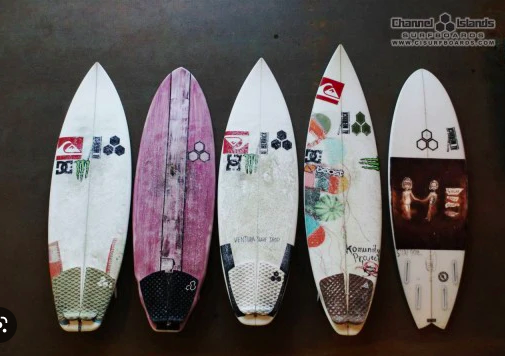The Evolution of Surfboard Design and How it Affects Your Surfing Experience
Riding the right surfboard will make all the difference in the amount of fun and success you have in the ocean. This applies to first time surfers as well as the best surfers in the world. Surfboards in the late 90’s and early 2000’s were narrow, thin, and “knifey”. This meant low volume, poor paddle power, and poor glide/speed generation. This trend reversed do to highly influential surfers like Dane Reynolds and Kelly Slater who started riding short stubbier boards with more surface area in the chest area and overall volume. At first these boards were considered ugly and gimmick; however, they are now the norm in line ups around the world. It has made surfing easier, more fun, and more innovative than ever before.
Kelly Slater’s “Knifey” Shortboards
While the shortboard revolution has forever changed the performance surfing in the upper echelons of our sport, this same concept trickled down through all types of board designs. The twin fin, single fin, and mid length renaissance as been in full effect for the last ten years or so which can be seen in every line up in the world. It wasn’t long ago that every surfer was carrying a high performance shortboard to their local average beach break. Nowadays folks are surfing boards appropriate for their skill level and the waves at their home break. Alternative shapes now out number traditional high performance shortboards on average days here in Charleston which makes perfect sense. Who wants to be stomping on a shortboard in knee high waves when you can be surfing with speed and flow on a twin fin, mid length, or even a longboard surfboard?
Dane Reynolds “Alt” quiver
The surfing community has always been a stubborn one. Change is often resisted and takes years to be accepted, but it feels like we have entered a new realm of surfboard design where thinking outside the box is not only accepted, but actually encouraged. Surfing is about fun, not just performance. While those go hand in hand I believe the fun factor now outweighs the high performance needs of your average surfer.
Asher Pacey has shifted board design in the last ten years. He’s shown what is possible on alternate crafts.
What does this mean for you and your surfing? In short, it means we all have access to a ton of different crafts from your local shapers as well as major brands and there has never been a better time to explore alternate shapes and find what works best for you. I think it is imperative that every surfer has a longboard or a mid-length surfboard in their quiver living in Charleston. While the high performance shortboards will always have a place in the waves on Folly Beach, the majority of days will be ridden on something a little wider and floatier and fun.
Surfboard design and innovation is directly correlated with the new found inclusion and diversity in surfing. In the late 90’s and early 2000’s surfing was a white male dominated sport with 90% of surfers riding ridiculous high performance surfboards. With a shift in the industry and culture, surfing has become a lot more open minded to alternative shapes and running parallel to that theme, we have also seen a huge increase in women and minority surfers. This has been incredible to watch develop over the last 15 years or so. We have the most excited crop of young women surfers on the World Tour we’ve ever seen with Caity Simmers, Molly Picklum, and BettyLou Sakura Johnson. Check out the CT ranking for the women here. Surfing is becoming more accessible for all walks of life and I believe this will be the theme for the sport for the next decades. It’s fun and meant for everyone!
Jordy Smith headed out with local kids in his hometown of Durban.
Surfing inclusion organizations:
Some of our favorite board models at the moment:




